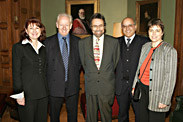Engineering e-learning
Nearly 200 delegates descended on McGill on November 26 for the Conférence des recteurs et des principaux des universités du Québec (CREPUQ) conference on technology in the classroom.

Left to right: Josianne Basque (TÉLUQ); guest speaker Tony Bates; Robert Thivierge, CREPUQ; CIO Tony Masi, McGill; senior educational technologist Laura Winer, McGill
Owen Egan
Called "Pedagogical Engineer-ing," the one-day conference addressed a wide variety of topics related to teaching and technology, including how to conceive of programs and platforms to deliver education, developing evaluation methods to determine quality of online learning tools and integrating technology planning in a university setting.
Deputy Provost and Chief Information Officer Tony Masi said that McGill and CREPUQ have had a fruitful relationship on these issues for years.
"There is no reason for each institution to reinvent the wheel when it comes to educational technology interventions. There is real value in co-operation and collaboration, even when that's not possible for a variety of reasons, information-sharing goes a long way to helping us understand what we are doing right, what we are doing wrong and how close our work in this area is to best practices,'" said Masi.
Josianne Basque, a professor with TÉLUQ (the Université du Québec's institute for distance learning), explained that the conference aimed to address both the theoretical and practical aspects of new technology's impacts on education. The conference provided a valuable networking opportunity for the delegates from the 20 member institutes of CREPUQ.
"When it comes to instructional engineering, we don't get too many chances to talk to each other. As professors, we are subject matter experts; we don't have training in pedagogy," she said.
The issues are not exactly new. Technology has always been incorporated into teaching. However, the rapid pace of technological development keeps the issue at the forefront. Pedagogy is not always a priority for university instructors, nor is incorporating and sharing innovations in the classroom. The November 26 conference allowed participants to talk of where their own institutions stood in terms of planning and development, as well as share research in this field.
The invited speaker at lunch was University of British Columbia professor Tony Bates. Bates has been the director of Distance Education and Technology, Continuing Studies at UBC since 1995. He has written several books on distance education and was a Professor of Educational Media Research at the British Open University. He has also served as a consultant for numerous international bodies, such as the World Bank and UNESCO.
Despite his enormous international experience, Bates began his talk at the Faculty Club by admitting he wasn't sure that he could give much useful advice to Quebec universities: "Quebec is a leader in e-learning," he said.
Bates's talk, entitled "Re-engineering the Institution to Support E-learning," focused less on the technology and teaching, and more on the planning behind incorporating technology.
Technology in teaching rides a continuum from least technological (a classroom with a chalkboard) to the most technological (distance learning). In the middle is "mixed mode," where the classroom might incorporate PowerPoint slides or have extracurricular web-based components.
The costs of these vary. Straight classroom learning is relatively stable in terms of cost: it is just as expensive to deliver a lecture to a class of 30 people as 300 on a per student basis, once teaching assistants are accounted for. Mixed media classrooms cost a bit more, but are also steady no matter the number of people taking them.
Distance learning becomes very cheap on a per student basis the more pupils there are, as economies of scale kick in for printing and web costs. These are issues that universities need to consider when planning their classes. However, there are a wide variety of other factors that go into good decision-making beyond dollars and cents.
"You have to look at the external effects, funding, what the knowledge base is and what the markets are. This can include graduates who want to know what the latest developments are in their fields. This group has been estimated to be as large as or larger than the market that is leaving high school," said Bates, adding that this latter market is particularly likely to want, and be able to benefit from, self-directed distance learning environments. Training younger students to learn with these approaches can be part of an integrated planning process.
"In my experience, 18-year-olds just out of high school do not make good distance learners. Lifelong learners do. We have to think about our curriculums to move from one to the other, perhaps by incorporating some e-learning strategies in first-year classes," he said.
Leadership on these questions does not have to come from the top levels of a university, but it must be supported there. It is key that those who have responsibility for technology issues truly understand their portfolio. Most importantly, the goals must be understood by all, no matter what they are.
"It's not the vision that is important, it's how you get there," he said.
Masi said that an inchoate approach has often marked the integration of technology in the classroom: "The pedagogical underpinnings that are meant to support technology in the classroom are often derived from studies of paper-based materials (or they are not based on research at all). Efforts are inconsistently organized, and our understanding of technology in the classroom (or at a distance) do not adequately address cross-cultural, linguistic and international diversity."
To focus their resources in an effective way, Masi suggested that universities ensure they have sufficient resources, emphasize learning as much as teaching and benchmark the work being done to determine best practices.
"In short, we have to overcome the obstacles and embrace opportunities," he said.
